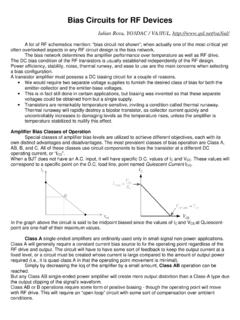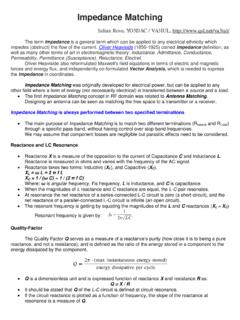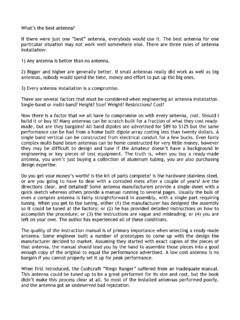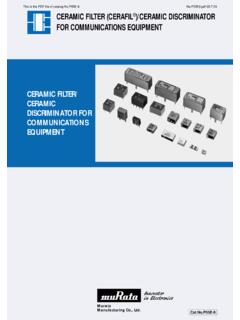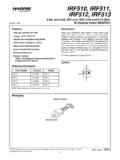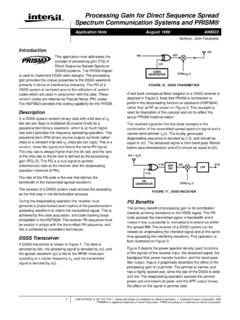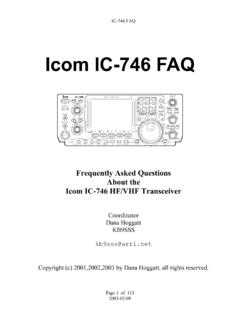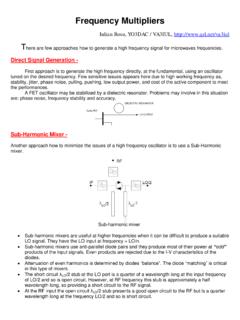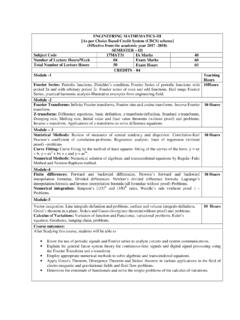Transcription of Fiber-Optic Communications Systems, Third Edition. …
1 Fiber-Optic Communications Systems, Third P. AgrawalCopyright 2002 John Wiley & Sons, : 0-471-21571-6 (Hardback); 0-471-22114-7 (Electronic) Fiber-Optic communication Systems Third edition GOVIND E? AGRAWAL The Institute of Optics University of Rochester Rochester: NY WILEY- 623 INTERSCIENCE A JOHN WILEY & SONS, INC., PUBLICATION Designations used by companies to distinguish their products are oftenclaimed as trademarks. In all instances where John Wiley & Sons, Inc., isaware of a claim, the product names appear in initial capital or ALLCAPITAL LETTERS. Readers, however, should contact the appropriatecompanies for more complete information regarding trademarks 2002 by John Wiley & Sons, Inc. All rights part of this publication may be reproduced, stored in a retrieval systemor transmitted in any form or by any means, electronic or mechanical,including uploading, downloading, printing, decompiling, recording orotherwise, except as permittedunder Sections 107 or 108 of the 1976 United States Copyright Act, withoutthe prior written permission of thePublisher.
2 Requests to the Publisher for permission should be addressed tothe Permissions Department, John Wiley & Sons, Inc., 605 Third Avenue,New York, NY 10158-0012, (212) 850-6011, fax (212) 850-6008,E-Mail: publication is designed to provide accurate and authoritativeinformation in regard to the subjectmatter covered. It is sold with theunderstanding that the publisher is notengaged in rendering professionalservices. If professional advice or other expert assistance is required, theservices of a competent professional person should be 0-471-22114-7 This title is also available in print as ISBN more information about Wiley products, visit our web site My ParentsContentsPrefacexv1 Perspective .. for Fiber-Optic Communications .. of Lightwave Systems .. Concepts .. and Digital Signals .. Formats .. communication Systems .. system Components.
3 Fibers as a communication Transmitters .. Receivers .. 18 Problems .. 19 References .. 202 Optical Description .. Fibers .. Fibers .. Propagation .. s Equations .. Modes .. Fibers .. in Single-Mode Fibers .. Dispersion .. Dispersion .. Dispersion .. Limitations .. Propagation Equation .. Gaussian Pulses .. on the Bit Rate .. Bandwidth .. Losses .. Absorption .. Scattering .. Imperfections .. Optical Effects .. Light Scattering .. Phase Modulation .. Mixing .. Manufacturing .. Issues .. Methods .. and 70 Problems .. 72 References .. 743 Optical Concepts .. and Absorption Rates .. nJunctions .. Recombination.
4 Materials .. Current Lasers .. Gain .. and Laser Structures .. of Longitudinal Feedback Lasers .. Semiconductor Lasers .. Semiconductor Surface-Emitting Lasers .. Characteristics .. Characteristics .. Modulation .. Modulation .. Intensity Noise .. Linewidth .. Design .. Fiber Circuitry .. Modulators .. Integration .. and Packaging .. 124 Problems .. 126 References .. 1274 Optical Concepts .. Time and Bandwidth .. Photodetectors .. nPhotodiodes .. i nPhotodiodes .. Photodetectors .. Design .. End .. Circuit .. Receivers .. Noise .. Mechanisms .. i Sensitivity .. Rate .. Received Power .. Limit of Photodetection.
5 Ratio .. Jitter .. Performance .. 174 Problems .. 176 References .. 1785 Lightwave Architectures .. Links .. Networks .. Guidelines .. Lightwave Systems .. Lightwave Systems .. Budget .. Budget .. Systems .. Lightwave Lightwave of Power Penalty .. Noise .. Pulse Broadening .. Noise .. Chirping .. Feedback and Design .. 217 Problems .. 219 References .. 2206 Optical Concepts .. Spectrum and Applications .. Optical Amplifiers .. Design .. Characteristics .. Amplification .. Applications .. Amplifiers .. Gain and Bandwidth .. Characteristics .. Fiber Amplifiers .. Amplification .. Amplifiers .. Applications .. Preamplification .. Accumulation in Long-Haul Timing Jitter.
6 Dispersive and Nonlinear Effects .. Impairments .. 271 Problems .. 272 References .. 273 CONTENTSxi7 Dispersion for Dispersion Management .. Schemes .. Technique .. Coding Techniques .. Prechirp Fibers .. Filters .. Bragg Gratings .. Gratings .. Fiber Mode Couplers .. Phase Conjugation .. of of Self-Phase Modulation .. Signal .. Lightwave Dispersion Maps .. Nonlinear Dispersion Compensation .. Dispersion Compensation .. Dispersion Management .. Compensation .. 317 Problems .. 321 References .. 3228 Multichannel Lightwave Systems .. Point-to-Point Links .. and Metro-Area Networks .. WDM Networks .. Components .. Optical and Demultiplexers .. Drop Multiplexers .. Couplers .. Routers.
7 Cross-Connects .. Transmitters and Receivers .. Performance Issues .. Linear Crosstalk .. Linear Crosstalk .. Raman Crosstalk .. Brillouin Scattering .. Modulation .. Mixing .. Design Issues .. Multiplexing .. Demultiplexing .. Performance .. SCM SCM Systems .. SCM Systems .. Multiplexing .. Encoding .. Encoding .. 390 Problems .. 393 References .. 3949 Soliton Solitons .. Schr odinger Equation .. Solitons .. Communications .. Transmission with Solitons .. Interaction .. Chirp .. Transmitters .. Soliton Broadening .. Amplification .. Solitons .. Dispersion Maps .. Issues .. of Amplifier Noise .. Method .. and Frequency Fluctuations .. Jitter.
8 Of Timing Jitter .. Soliton Systems .. Design Issues .. Interaction .. of Higher-Order Effects .. Jitter .. Soliton of Lumped Amplification .. Jitter .. Management .. 463 Problems .. 468 References .. 46910 Coherent Lightwave Basic Concepts .. Local Homodyne Detection .. Heterodyne Signal-to-Noise Ratio .. Modulation Formats .. ASK Format .. PSK Format .. FSK Format .. Demodulation Heterodyne Synchronous Demodulation .. Heterodyne Asynchronous Demodulation .. Bit-Error Rate .. Synchronous ASK Receivers .. Synchronous PSK Receivers .. Synchronous FSK Receivers .. Asynchronous ASK Asynchronous FSK Asynchronous DPSK Receivers .. Sensitivity Phase Noise .. Intensity Polarization Fiber Dispersion.
9 Other Limiting system Performance .. Asynchronous Heterodyne Systems .. Synchronous Heterodyne Systems .. Homodyne Systems .. Current 510 Problems .. 511 References .. 512A system of Units518xivCONTENTSB Acronyms520C General Formula for Pulse Broadening524D Ultimate system Capacity527 References .. 528E Software Package529 PrefaceSince the publication of the first edition of this book in 1992, the state of the art offiber-optic communication systems has advanced dramatically despite the relativelyshort period of only 10 years between the first and Third editions. For example, thehighest capacity of commercial Fiber-Optic links available in 1992 was only mere 4 years later, the wavelength-division-multiplexed (WDM) systems with thetotal capacity of 40 Gb/s became available commercially. By 2001, the capacity ofcommercial WDM systems exceeded Tb/s, and the prospect of lightwave systemsoperating at Tb/s or more were in sight.
10 During the last 2 years, the capacityof transoceanic lightwave systems installed worldwide has exploded. Moreover, sev-eral other undersea networks were in the construction phase in December 2001. Aglobal network covering 250,000 km with a capacity of Tb/s (64 WDM channelsat 10 Gb/s over 4 fiber pairs) is scheduled to be operational in 2002. Several conferencepapers presented in 2001 have demonstrated that lightwave systems operating at a bitrate of more than 10 Tb/s are within reach. Just a few years ago it was unimaginablethat lightwave systems would approach the capacity of even 1 Tb/s by second edition of this book appeared in 1997. It has been well received bythe scientific community involved with lightwave technology. Because of the rapid ad-vances that have occurred over the last 5 years, the publisher and I deemed it necessaryto bring out the Third edition if the book were to continue to provide a comprehensiveand up-to-date account of Fiber-Optic communication systems.
